11 Crucial Metrics for Enhancing User Experience and Driving Revenue Growth in Publishing
Learn how publishers can boost revenue by tracking sophisticated metrics to enhance User Experience and Content Quality and avoid domain blockage by advertisers. This article explores essential metrics, insightful strategies, and industry references for optimal Ad Monetization.

In today's rapidly evolving digital landscape, publishers face both challenges and opportunities while monetizing their websites through online ads. To unlock the full potential of revenue generation, publishers must delve into sophisticated Key Performance Indicators (KPIs) that not only drive revenue growth but also enhance the user experience and content quality metrics.
With an economic downturn comes brands’ budget reductions, prompting publishers to cope with declining advertising revenue. In response, publishers are focusing more on diversifying their revenue streams, which has become both an opportunity and a necessity.
As advertisers grapple with tighter budgets, brands are increasingly drawn to publishers capable of establishing and maintaining trusted relationships with their readers.
According to Craig Hughes, Vice President of Corporate Development and Strategic Partnerships at Outbrain, “This trust also empowers publishers to create new engagement opportunities and diversify revenue streams. By providing readers and subscribers with more personalized offerings and experiences, publishers can provide different ad experiences — another major focus area for 2023”
To enhance reader experience and grow their audiences, publishers are closely monitoring essential metrics to encourage better user experience as a means to even more successful partnerships and campaigns. Some online publishers are also getting ready for cookieless data operations.
So, what KPIs should Publishers be Tracking to Enhance User Experience?
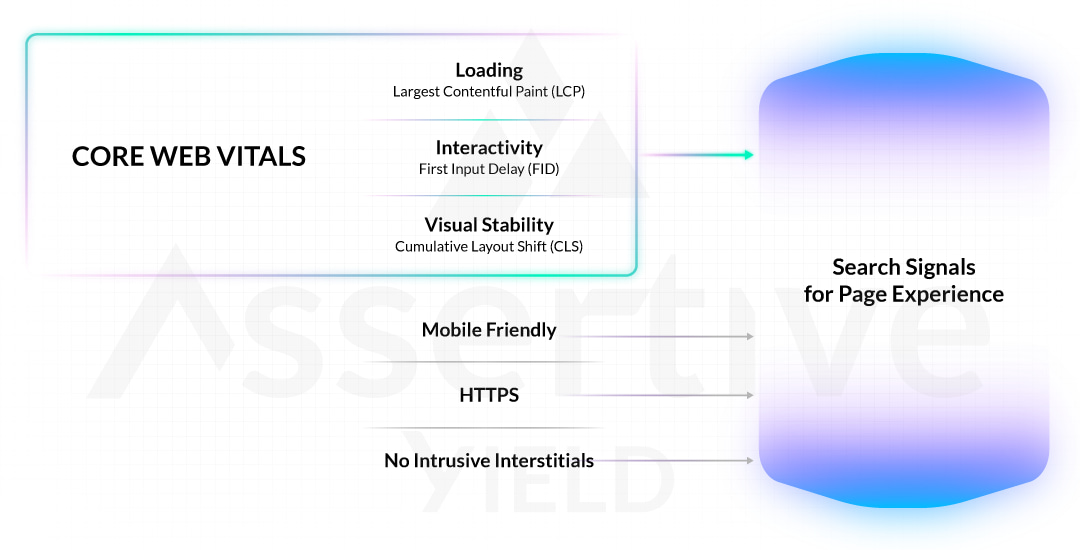
Core Web Vitals
In May 2021, Google initiated the implementation of new metrics called Core Web Vitals for ranking on Google Search. The Core Web Vitals evaluate the Loading (LCP), Interactivity (FID), and Visual Stability.
These new metrics are achieved by establishing performance time ranges for each of these as either good”, "needs improvement", or "poor". To gauge the overall performance of a page or website, the 75th percentile measurement is utilized. If a minimum of 75% of page views surpass the "good" threshold, the website receives a very strong mark for that particular metric.
Tracking Google Core Web Vitals is crucial for publishers as it directly impacts search engine rankings and may indicate negative effects on user experience. By optimizing them, publishers can enhance the overall quality of their websites, leading to improved user satisfaction, longer visit durations, and lower bounce rates.
Moreover, as Google incorporates Core Web Vitals into its ranking algorithms, well-optimized sites are more likely to achieve higher search engine rankings, resulting in increased visibility and organic traffic.
Research shows that when a site meets the Core Web Vitals thresholds, users are 24% less likely to abandon page load. On another note, Farfetch reported that with each 100ms reduction in Largest Contentful Paint (LCP), their web conversion rate increased by 1.3%.
Consequently, reducing Cumulative Layout Shift (CLS) by 0.2 also led Yahoo! JAPAN to a 15% increase in page views per session, 13% longer session durations, and a 1.72 percentage point decrease in bounce rate and redBus also reported that reducing CLS from 1.65 to 0 significantly uplifted domain rankings globally.
Therefore, monitoring and improving Core Web Vitals not only fosters better user engagement and user experience but also helps publishers maintain and improve their web pages and bounce rates.
Jeff Moriarty, executive vice president and Chief Product Officer at Nexstar advises “Focusing on speed will improve many metrics, such as pages per session. Once a site loads quicker, ads and content can be delivered faster — making both advertisers and users happy. At the end of the day, write good headlines, create content that people want to read, and make sure it loads quickly”
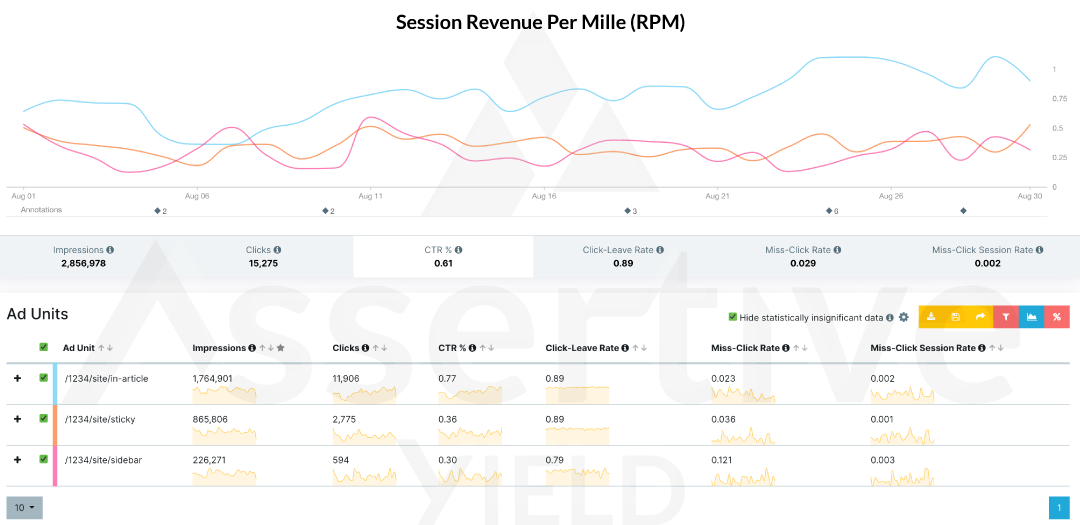
Session Revenue Per Mille [RPM]
One critical metric that has emerged as a key indicator of a publisher's financial performance is Session Revenue Per Mille (RPM). RPM refers to the revenue generated for every thousand sessions on a publisher’s website or platform. It is a powerful metric that provides insights into the effectiveness of a publisher's monetization strategies, content quality, and user engagement levels.
Session RPM is a pivotal metric for publishers to enhance revenue generation and refine their strategies. It gauges the ability to convert user engagement into revenue, aiding in the assessment of monetization methods like ads, subscriptions, and sponsored content.
By analyzing content performance, publishers can tailor their strategies to emphasize topics that resonate with audiences, attracting advertisers for premium ad placements.
Session RPM is calculated by dividing the total revenue generated from a given period by the number of sessions during the same period and then multiplying by a thousand to normalize the value. The formula is as follows:
Session RPM = (Total Revenue / Total Sessions) * 1000
For instance, if a publisher earns $1,500 from 100,000 sessions in a month, the Session RPM would be: Session RPM = ($1,500 / 100,000) * 1000 = $15
High Session RPM signifies robust user engagement, indicating extended site visits and interactions, appealing to advertisers, and leading to heightened competition for ad placements. Publishers can optimize ad positions based on Session RPM data, maximizing revenue while maintaining user experience.
Additionally, monitoring Session RPM trends across different timezones can help publishers identify revenue patterns, enabling strategic adjustments to leverage peak periods and address downturns (there are tools where you can analyze Session RPM for free).
Pages Per Session
"Pages per session (PPS)" serves as a measure indicating the average count of pageviews a visitor does during a single browsing session on a website. A heightened figure suggests that the content holds user interest, prompting them to delve deeper into the site.
This metric offers valuable insights into user engagement and retention, presenting a comprehensive grasp of the website's ability to captivate its audience.
The PPS metric is different for individual websites - as some may offer more static experience (like watching a live stream or playing a game) and others may fire multiple “virtual pageviews” on the same page to differentiate between how deep a user is going down the page. In all cases though, increasing PPS comes with more ads to be shown within a user session.
In contrast to the "time-on-site" metric, which imparts only limited information, "pages per session" offers a more thorough perspective by capturing every page loaded throughout a session. Notably, news and content-oriented websites effectively employ this metric by utilizing "related stories" links to stimulate users to explore additional content within the site.
However, there are instances where publishers misuse this metric to inflate pageviews and boost ad revenue. As an example, showing the home page to users trying to get back the original referrer - a practice that may boost the ad impressions, but will most certainly decrease viewability. Such practices can result in a negative user experience and deter repeat visits.
To enhance the PPS metric genuinely, it is crucial for publishers to prioritize user experience, create compelling and personalized content, present opportunities for meaningful clicks, and steer clear of tactics that compromise quality.
By adopting these measures, users will develop trust in the quality of the content, subsequently steering towards increased navigation on the site, potentially leading to sustained revenue growth over the long term.
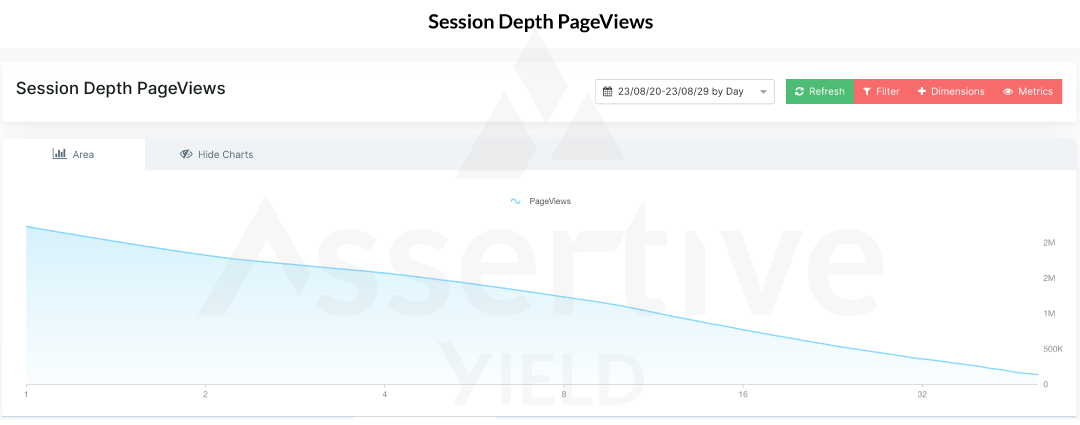
Click-Through Rates (CTR)
CTR serves as a valuable performance metric in digital advertising, publishers monitor the CTR to assess how well ads resonate with their audience.
A high CTR may indicate engaging ad creatives and can increase the value of ad placements while helping them to make informed decisions about ad content, design, and placement. It can also mean an issue with ad placement, leading users to missclick on ads.
Monitoring the CTR metric is an essential practice that offers valuable insights into how well ads are resonating with the intended audience.
Publishers can gauge whether the content, design, placement, and targeting strategies are effective in capturing the attention of users and motivating them to take action (i.e., click on the ad). This information is particularly beneficial for fine-tuning ad campaigns and optimizing the overall ad inventory.
Furthermore, Ads with a high CTR are often considered more valuable in terms of ad placements because “Advertisers are willing to pay more for ad space that consistently generates clicks and conversions. This can lead to increased revenue for publishers, as they can charge higher rates for prime ad placements that demonstrate strong engagement metrics” Nils Lind, CEO/Founder of Assertive Yield.
That being said, it’s more and more common these days for advertisers to buy traffic based on certain conversions, as opposed to clicks, as high CTR is not useful for them if it just results in a higher bounce rate and lack of engagement from people clicking on the ad.
Active Engagement Time vs. Time spent on page
Active Engagement Time and Time Spent on Page are two metrics that publishers often use to measure the effectiveness of their content and the engagement levels of their audience. Both metrics can provide valuable insights into how users are interacting with your content, but they focus on slightly different aspects.
This distinction informs content placement, design, and user interface improvements, ultimately boosting user satisfaction.
Active Engagement Time
Active Engagement Time refers to the time that a user spends actively interacting with a publisher’s content. This could include actions like scrolling, clicking, typing, watching videos, filling out forms, or any other type of engagement that indicates the user is actively involved with the content.
It's a more qualitative metric that aims to measure how engaged users are with the content beyond simply having the page open.
Time Spent on Page
Time Spent on Page, on the other hand, is a quantitative metric that measures the total time a user spends on a specific page. It indicates the duration between when a user arrives on a page and when they navigate away from it. This metric doesn't distinguish between active interaction and passive consumption – a user could leave a page open in a tab on a second monitor without actively engaging with it.
A careful balance between active engagement time and total time spent on a page is crucial for gauging user interaction. By integrating web analytics tools, like Google Analytics, Adobe Analytics, AY Yield Intelligence, or other third-party solutions into your website, tracking these metrics can be helpful in understanding user behavior.
It is also crucial to regularly review your analytics data to identify patterns and trends, then use this information to make iterative improvements to your content and engagement strategies.
Remember that both metrics should be interpreted in context. High Time Spent on the Page doesn't necessarily indicate high engagement if users are leaving the page open without interacting.
Combining both metrics and understanding user behavior and experience can help publishers make informed decisions to boost revenue, and improve user engagement and satisfaction.

Scroll Depth
This number shows you how far (25-50-75%) the user scrolled down a webpage, which is important for today’s long scrolling sites and, of course, for mobile. This metric measures engagement and shows how interested readers are in your content. By analyzing this data, publishers can tailor content presentation, and ad placement to capture and retain user attention effectively.
Page scroll depth can also be measured in pixels. When measured this way, it’s sometimes also called pixel depth. Pixel depth values are typically rounded, so a user who scrolled 5,132 pixels down the page might have a reported pixel depth of 5,000. Google, however, gave a rather straight-to-the-point method of analyzing the scroll depth analytics in Google.
The scroll depth metric offers publishers a refined perspective on content effectiveness. Understanding where users typically drop off or lose interest on a page enables publishers to strategically reposition content elements and advertisements, thereby maximizing the chances of delivering the intended message.
Additionally, analyzing this metric can inform the development of compelling ad creatives that align with user-scrolling patterns, optimizing visibility and engagement, empowering publishers to navigate the intricate interplay between user behavior and content presentation, leading to increased page views, prolonged on-site durations, and ultimately, improved advertising campaigns.
Monitoring the Hidden Costs of Ad Operations
It's crucial for publishers to keep a watchful eye on the hidden costs tied to ad campaigns. While generating content, hosting fees, and costs of doing business can’t be escaped, it's the less apparent costs that can significantly impact a publisher's revenue.
On the publisher's side of things, the expenses linked to every impression warrant careful consideration. Whether an impression results in a filled ad space or not, and regardless of whether it's seen by users, there's always a serving fee involved. This alone underscores the need for active monitoring.
For instance, this is especially true if you are a GAM 360 publisher, or you are working with companies taking a cut out of each impression in exchange for optimizations. These expenses, tied to the volume of incoming traffic, eat into the profit earned per ad impression.
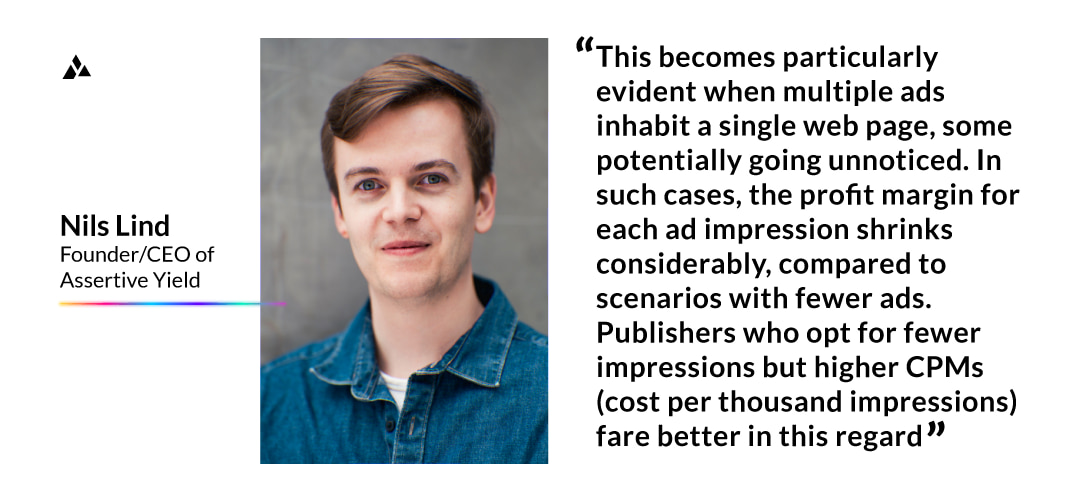
Nils also iterated that this economic reality has led many notable publishers, even those who purchase traffic, to adopt cleaner layouts. These streamlined designs ensure only a few ads are visible at a time – perhaps just one or two. By doing so, these publishers reduce the chances of accidental clicks and prioritize genuine engagement metrics like real clicks and views.
In essence, being vigilant about hidden costs in ad campaigns is a must for publishers. The less obvious expenses, often overshadowed by more visible ones, can collectively eat into profits. Assess the performance of all Prebid vendors, ensure that the Prebid setup is functioning optimally, and identify crucial KPIs that could affect performance.
Therefore, understanding these covert revenue implications and making strategic changes to campaign approaches and layouts empower publishers to navigate the ever-changing landscape of digital advertising.
Environmental Impact and Carbon Emissions
With the advertising industry actively pursuing an eco-friendly environment and keeping an eye on its carbon emissions, websites now undergo evaluation based not only on clicks and conversions but also on projected CO2 emissions pioneered by companies like Scope3 and Jounce Media.
“Emissions data is becoming an additional campaign metric alongside other performance metrics for the media and advertising industry. Making progress to decarbonize relies on our ability to know how much CO₂e actually goes into the atmosphere from digital advertising” Scope3
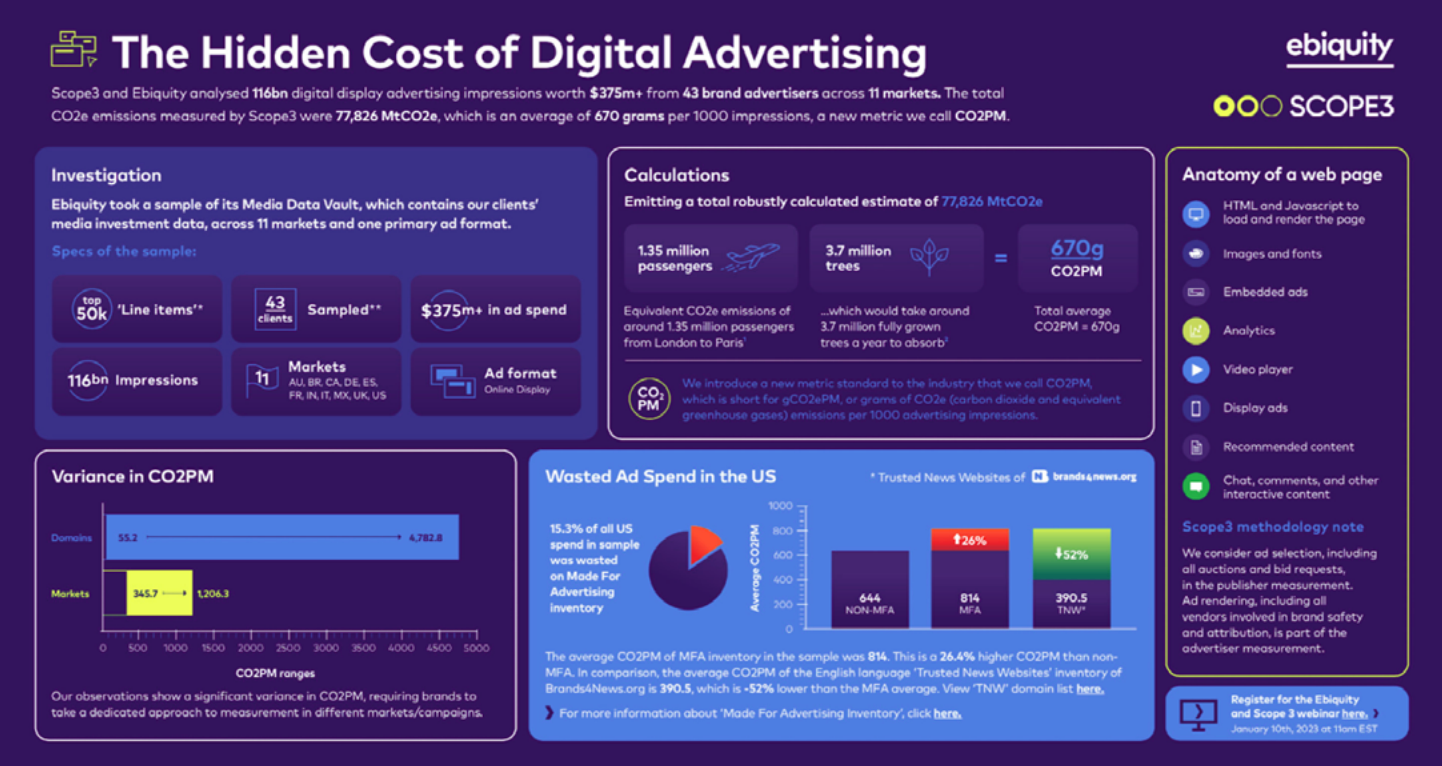
Variables like ad density and ad-friendly website design are now considered. These formerly overlooked factors significantly impact both the carbon footprint and ad campaign efficacy.
Publishers recognize that excess low-quality inventory, such as unseen or ineffective impressions, yields negative results. These situations not only disappoint advertisers but also contribute to heightened digital traffic and subsequently increased CO2 emissions. The link between digital clutter and environmental impact prompts a strategic rethink.
Nils further pointed out that “Carbon emissions tied to campaigns have become standalone data points. Advertisers prioritize campaigns aligned with sustainability goals, moving beyond audience reach and conversions. This shift towards environmentally conscious ad spending leads to budgets that prioritize eco-friendly practices, signifying a deeper effort to align advertising with broader societal concerns”
Monitoring carbon emissions in ad campaigns goes beyond a fleeting trend. As the industry develops and monitors other success metrics, publishers must weigh the environmental impact of ad campaigns on their websites to avoid being bypassed by advertisers and brands. What are Publishers, SSPs, and Ad tech's roles towards Green Programmatic? By reducing digital Ads inventory, educating advertisers & marketers, and tackling revenue loss through green traffic, by using a high-quality prediction model. Shaping a Greener Future for Programmatic e-book goes deeper into this topic, explaining buy-side and sell-side roles and recent initiatives in this direction. Highly recommended reading!
User Lifetime Value: A Holistic Approach to User Engagement
User Lifetime Value (LTV) emerges as a vital metric within digital advertising, offering a holistic framework that not only maximizes user engagement but also safeguards publishers against potential ad blocks caused by low domain scores.
This multifaceted approach transcends short-term gains, allowing publishers to nurture lasting relationships with users. By closely monitoring the LTV metric, publishers can comprehend the long-term impact of user interactions, which in turn influences domain scores positively.
As advertisers evaluate domains for potential partnerships, a low domain score could trigger ad blocking due to concerns about quality and engagement. However, an emphasis on LTV showcases publishers' commitment to cultivating meaningful interactions, elevating domain scores and thereby reducing the risk of ad blocks while optimizing revenue.
In this dynamic digital ecosystem, publishers must adopt sophisticated KPIs to navigate challenges, drive revenue, and prioritize user-centric experiences.
By integrating insights from various sources, studies, reports, and analyses stated in this article, publishers can propel their ad monetization strategies to new heights, achieving a balance between revenue maximization, better Content Quality, User experience, and User engagement.
Tools that provide Yield Intelligence consolidates all your revenue data in one place in real-time across every dimension - Prebid, Dynamic Allocation, and Direct - with tremendous granular data and hundreds of metrics extended with your custom data segments and audiences. Here's a video demonstration in case you would like to explore how it works.
To improve your content strategy backed with data, use customized dashboards to assess content performance, revenue split out by author, site section, article, and more! Learn more about how to build dashboards to boost Content Revenue & User Experience.
Frequently asked questions
Which Ad Revenue Metrics Should Publishers Track?
Publishers should track metrics like Session Revenue Per Mille (RPM), Pages Per Session, Click-Through Rates (CTR), and Core Web Vitals to evaluate user engagement, content effectiveness, and revenue performance.
What are the main UX metrics for publishers?
UX metrics for publishers include Core Web Vitals (Loading, Interactivity, Visual Stability), Active Engagement Time vs. Time Spent on Page, Scroll Depth, and User Lifetime Value (LTV) to assess user interaction and content engagement.

How to Enhance Viewability Metric for Digital Publishers
Read more

Understanding Cost Per Mille(CPM) in Digital Advertising
Read more

Q2'24 AY Industry Insights Report - Publisher Trends, Global Programmatic & Ad Revenue
Read more



